Marketing has taken some 70 years to reach human-centric marketing from product-driven and customer-orientated focus. The next phase according to Philip Kotler et al. was the transformation from traditional marketing to digital where both the offline and online where co-existing with an omnichannel approach.
Marketing 5.0 talks about three challenges that we are currently facing: a generation gap, prosperity polarisation and the digital divide.
We have currently five different generations from Baby Boomers to Generation Alpha giving marketers different challenges to target and serve customers with different expectations, values and tech-savviness.
The authors define Marketing 5.0 as “the application of human-mimicking technologies to create, communicate, deliver, and enhance value across the customer journey.” Technology should follow strategy and humans should be working in symbiosis with new technologies utilising the best leverage and advantages of both.
Machines are good at recognising patterns of actions (behaviour) whereas humans are adept at underlying motives for actions (attitudes and values of customers).
Marketing 5.0 consists of five components that technology enables: data-driven, predictive, contextual, augmented and agile marketing. The three middle ones are interrelated applications that are built on the first and last organisational disciplines.
Since everything is tech-based the whole approach relies on big data capabilities that drive the whole marketing but also product development and the rest of the organisation in providing new customer experiences that are frictionless and compelling.
The book outlines and describes the reality of startup companies that are from the outset agile and often also data-driven by necessity when trying to find their product-market fit.

